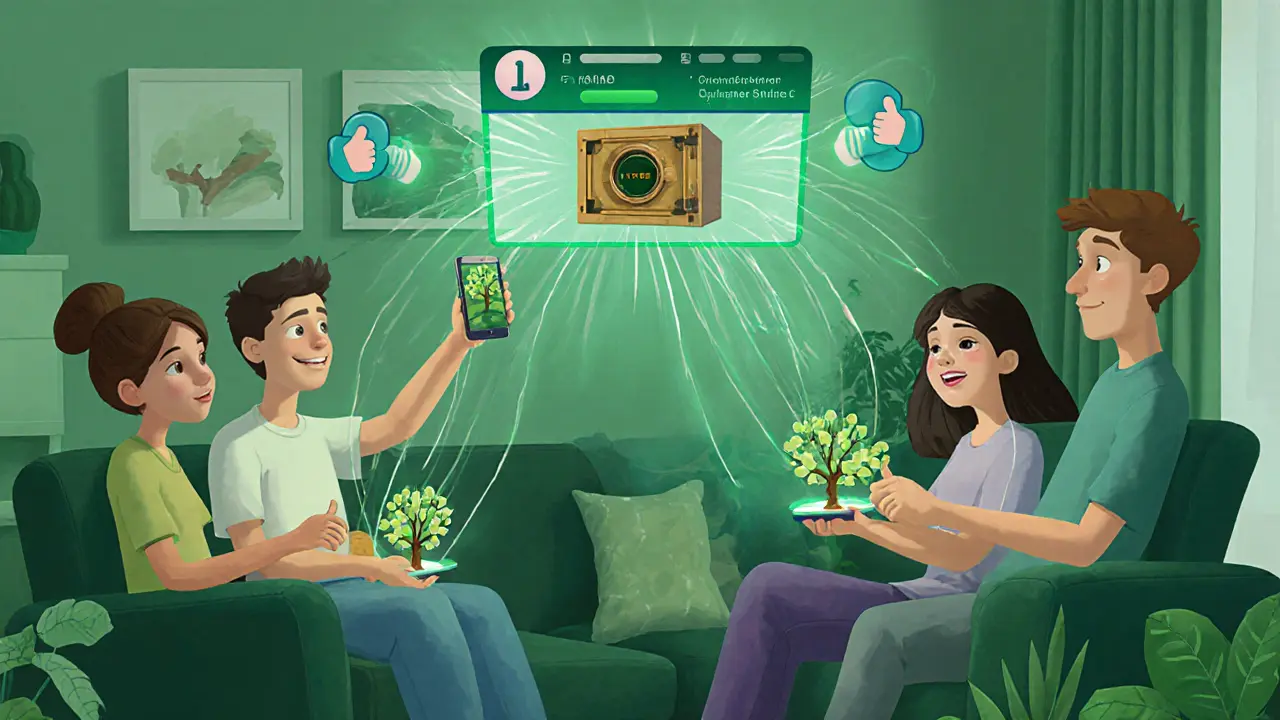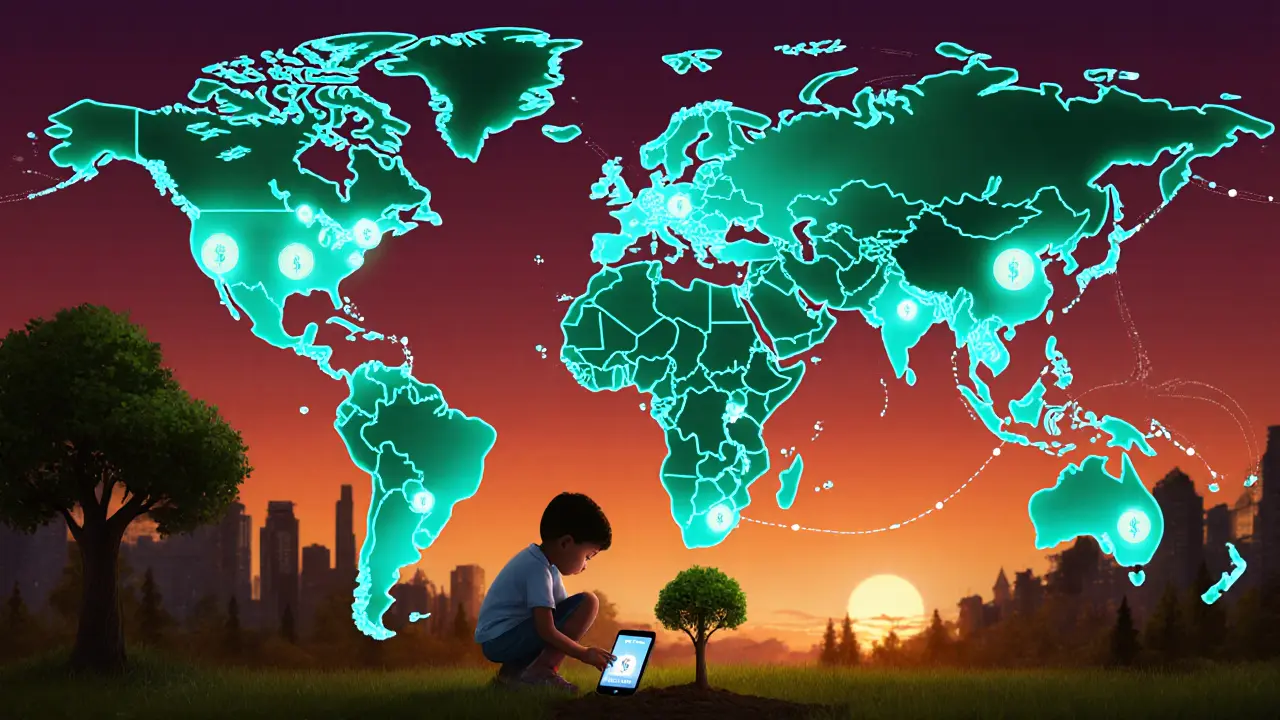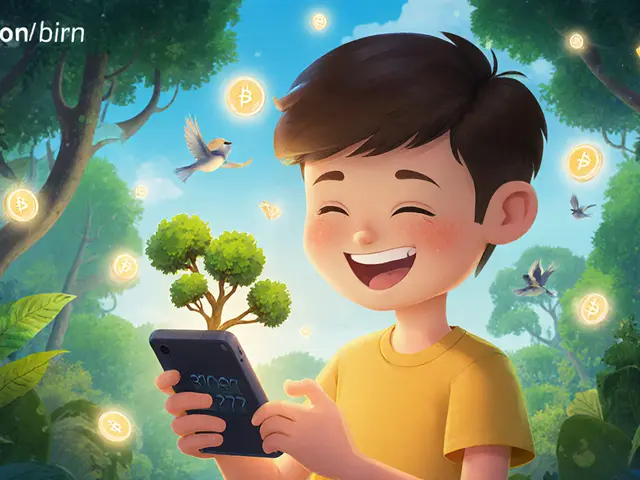MLC Environmental Impact Calculator
How Your Gameplay Plants Trees
Every time you play My Lovely Planet, you contribute to real environmental impact. Based on the project's current data, your gameplay directly supports tree planting through the Environmental Treasury.
Your Impact
My Lovely Planet (MLC) isn’t just another crypto coin. It’s a MLC coin built to turn mobile gaming into a force for real environmental change. If you’ve seen play-to-earn games where people grind for tokens only to watch the price crash a week later, MLC is trying to do something different. Instead of chasing quick profits, it ties your gameplay directly to planting trees and funding conservation projects. And it’s not just marketing-this one has data to back it up.
How MLC Works: Gaming That Plants Trees
My Lovely Planet is a mobile game you download on your phone. Inside, you play simple puzzle games, challenge friends, and earn in-game currency called Diamonds. But here’s the twist: you can convert those Diamonds into $MLC tokens-but only if you’ve staked at least $100 worth of MLC and reached certain levels. That’s not a random rule. It’s designed to stop people from jumping in, farming tokens, and leaving. The team behind it calls this the "Gaming Fee Switch" model. It’s meant to keep players engaged long-term, not just for a quick cash-out.
Every time you play, you’re not just passing time. You’re contributing to a system that’s already planted over 370,677 trees across the globe. That number is live on their website and updates in real time. The project doesn’t just say it cares about the planet-it shows it. And the money to plant those trees comes from the token economy itself. A full 15.22% of all MLC tokens are locked in an Environmental Treasury, which funds verified reforestation and conservation projects. Players even vote on which projects get funded through a decentralized governance system, or DAO.
Why MLC Is Built on Polygon
MLC runs on the Polygon blockchain, not Ethereum or Solana. That’s a smart move. Polygon is known for being fast, cheap, and energy-efficient-something most crypto projects don’t prioritize. While Bitcoin and older blockchains burn through electricity like a gas-guzzling truck, Polygon uses less than 0.01% of Bitcoin’s energy per transaction. For a project claiming to protect the planet, that matters. You can’t say you’re saving trees while running on a network that’s destroying the climate.
Using Polygon also means low fees. If you want to buy MLC with a credit card, you can do it directly through Transac, a fiat on-ramp partner. No need to first buy Bitcoin or Ethereum. You just open the app, tap "Buy MLC," enter your card details, and you’re in. That’s huge for regular mobile gamers who aren’t crypto-savvy. It removes one of the biggest barriers to entry in Web3 gaming.
The Tokenomics: Anti-Speculation by Design
Most play-to-earn tokens fail because they’re built like Ponzi schemes-early players get rich, late ones lose everything. MLC tries to avoid that. Here’s how:
- You need to stake $100 worth of MLC to convert Diamonds into tokens.
- Referral rewards only unlock after both you and the person you referred reach Level 20 in the game.
- There’s no massive token dump at launch-only 15.22% of supply is allocated to the Environmental Treasury, and the rest is locked in long-term incentives.
These aren’t just nice ideas-they’re technical barriers to speculation. They force players to stick around, play the game, and become part of the ecosystem instead of treating it like a casino. The result? A more stable price. As of October 30, 2025, MLC trades at $0.306133 USD, with little movement over the past month. That’s not explosive growth, but it’s also not a crash. It’s steady. And for a project trying to build something lasting, that’s better than a 10x pump and dump.

Market Position: Mid-Tier, But Unique
MLC is currently ranked #757 on CoinMarketCap. That’s not top 100. Not even top 100. But here’s what that number doesn’t tell you: most of the coins above it are pure speculation machines. MLC doesn’t compete on price spikes. It competes on purpose.
Compare it to Axie Infinity’s SLP token. SLP had a peak market cap of over $1 billion, then collapsed because players could farm tokens without ever playing the game. MLC makes farming impossible without real engagement. That’s why its 24-hour trading volume is $829,550-not huge, but consistent. It’s not trying to be the next Dogecoin. It’s trying to be the first crypto that actually helps fix the planet.
The project’s long-term goal? To become one of the top 30 cryptocurrencies by market cap. That would mean growing from its initial fully diluted market cap of $35 million to over $2.8 billion. That’s a 9,000% increase. Most analysts would call that unrealistic. But MLC’s model doesn’t rely on hype. It relies on user growth in a $200 billion mobile gaming market. If they can get just 5 million active players-most of them casual gamers who care about the environment-they could hit that target without needing crypto speculators at all.
Who Is MLC For?
MLC isn’t for day traders. It’s not for people looking to get rich overnight. It’s for three kinds of people:
- Mobile gamers who like puzzle games and want to do something meaningful while they play.
- Environmental supporters who want their digital activity to have a real-world impact.
- Long-term crypto believers who think sustainability matters more than short-term returns.
If you’re the kind of person who scrolls past ads for "earn crypto while you sleep," MLC might feel too slow. But if you’ve ever thought, "I wish I could use my phone time to help the planet," then this is your kind of project.

The Risks: Is MLC Too Ambitious?
Let’s be honest-MLC’s goals are huge. Planting millions of trees. Becoming a top 30 crypto. Changing how a $200 billion industry works. That’s not easy. And there are real risks:
- Can they really get millions of casual gamers to stake $100 worth of tokens? That’s a big ask.
- What if the environmental projects don’t deliver verifiable results? Public trust could vanish.
- What if competitors copy their model but with fewer restrictions and bigger rewards?
But here’s what’s interesting: MLC’s biggest strength might also be its biggest risk. The very rules that prevent speculation-staking, level gates, referral locks-are the same ones that could slow user growth. Casual players might get frustrated. They might say, "Why can’t I just earn tokens and cash out?" That’s the trade-off. MLC chose sustainability over speed.
How to Get Started
Getting into MLC is simple:
- Download the My Lovely Planet app from the App Store or Google Play.
- Create an account and start playing puzzle games.
- As you earn Diamonds, you’ll see the option to convert them to MLC-once you’ve staked $100 worth of tokens.
- Use your MLC to vote on environmental projects or buy more with a credit card via Transac.
You don’t need a wallet. You don’t need to understand DeFi. You just need a phone and 10 minutes a day.
Final Thoughts: A Different Kind of Crypto
My Lovely Planet isn’t trying to replace Bitcoin. It’s trying to replace the idea that crypto is just about money. It’s showing that digital tokens can be a tool for good. That’s rare. Most crypto projects talk about revolution. MLC is quietly planting trees.
Will it become a top 30 coin? Maybe. Will it change the gaming industry? Possibly. But even if it doesn’t hit those targets, it’s already doing something no other crypto has done at scale: turning screen time into forest growth. And in a world where so much of our digital life feels empty, that’s worth something.
Is My Lovely Planet (MLC) a scam?
No, MLC is not a scam. It’s a real project with a live mobile game, verifiable tree-planting data, and a transparent token economy. The team doesn’t hide behind anonymity-they’ve published a detailed whitepaper and track environmental results publicly. While the project has ambitious goals, the mechanics are open, and the token’s value is tied to actual gameplay and ecosystem participation, not just speculation.
Can I really earn money with MLC?
You can earn MLC tokens by playing the game, but it’s not a get-rich-quick scheme. The design intentionally limits fast cash-outs to prevent speculation. You need to stake $100 worth of MLC and reach Level 20 before you can convert your in-game Diamonds into tokens. Earnings are modest and slow, but stable. Think of it as earning rewards for consistent play, not gambling.
How do I buy MLC tokens?
You can buy MLC directly in the My Lovely Planet app using a credit card through Transac, a fiat on-ramp service. No crypto wallet is needed. You can also trade MLC on exchanges like BitMart and MEXC, but buying in-app is the easiest way for beginners. The token trades under the symbol $MLC on Polygon.
Does MLC have a future?
Its future depends on user growth, not price pumps. If My Lovely Planet can attract 5-10 million active players who care about sustainability, the token’s value could grow steadily over time. The model is designed for longevity, not short-term spikes. If the environmental claims hold up and the game stays fun, MLC could become a benchmark for eco-conscious crypto projects. If not, it may fade like many others. The key is whether people stick around to play-and plant.
Why does MLC require staking to earn tokens?
Staking $100 worth of MLC prevents speculative farming. Without this rule, people could create hundreds of fake accounts, play briefly, cash out, and leave-crashing the token’s value. The staking requirement ensures that only committed players can earn rewards. It’s a trade-off: you put in more upfront, but the system becomes more stable and fair for everyone who stays.
Is MLC environmentally friendly?
Yes, compared to most crypto projects. MLC runs on Polygon, which uses minimal energy-less than 0.01% of Bitcoin’s consumption. The project also plants real trees using funds from its Environmental Treasury. While no digital system is 100% zero-impact, MLC’s approach is among the most sustainable in crypto. It doesn’t just claim to be green-it ties its token economy to measurable ecological outcomes.


Comments
MLC sounds cool but staking $100 just to earn tokens? That’s a barrier for most casual gamers. I play games to chill not to invest. Also typo: 'staked' not 'staked'.
As a Nigerian woman who has seen too many 'eco-friendly' crypto scams, I am cautiously intrigued. The transparency of tree-planting data and Polygon’s low energy footprint gives me hope. This is not another vaporware project-it’s a quiet revolution in motion. The governance DAO is the real game-changer.
It’s not crypto. It’s therapy with a token.
Look, I’ve seen this before. Every ‘green crypto’ project claims to be different until the devs cash out and disappear. Polygon is cheaper, sure, but it’s still a blockchain-energy use isn’t zero. And ‘370k trees’? That’s less than 1% of what Amazon loses in a single fire season. This is performative environmentalism dressed in Web3 pajamas. You’re not saving the planet-you’re just giving guilt-ridden millennials a digital sticker to put on their profile. Also, why does the team need 15% locked in treasury? Sounds like a rug pull waiting to happen.
Why not just donate to Rainforest Alliance directly? This feels like over-engineered charity.
This is the kind of crypto I can get behind 🌱🎮 I play mobile games anyway-why not make it mean something? I’ve already staked my $100 and hit level 12. Feels good to play and plant at the same time. Let’s go MLC!
Some people are gonna hate this because it doesn’t promise riches. But that’s the point. Real change doesn’t happen in 24 hours. This project is building a culture, not a pump. I respect that. If you’re here for quick cash, go trade Shiba Inu. If you want to leave something better than you found? This is it.
15.22% locked? That’s still 50 million tokens. That’s enough to crash the market if dumped. And who’s auditing the tree planting? Who’s verifying it? No white hat firm listed. This smells like a vanity project for some Silicon Valley influencer’s side hustle.
What if the real value of MLC isn’t in the token price, but in the shift it represents? A generation choosing to play for purpose instead of profit. That’s a cultural shift bigger than any market cap. The coin is just the vessel. The real asset is collective intention.
Thanks for writing this. I’ve been skeptical of crypto for years, but this actually made me pause. I downloaded the app last night. Played for 15 minutes. Didn’t earn anything yet, but I felt… hopeful? That’s rare.
So you’re telling me I have to ‘stake’ and ‘level up’ to earn? That’s just a pay-to-win scam with tree emojis. And why is the team all American? This isn’t global-it’s colonial capitalism repackaged. Also, Polygon? That’s just a Layer 2 for rich people’s scams. You’re not saving the planet-you’re monetizing guilt.
The tokenomics are surprisingly well-structured. The staking requirement and referral locks are anti-gaming mechanics in the best way. Most P2E projects incentivize exploitation. MLC incentivizes patience. That’s rare. The real test is retention-will players stick around after the novelty wears off? I’ll be watching.
Played it for a week. No cash out yet. But I saw my first tree planted in Kenya. That’s enough for me. No need for hype. Just play. Plant. Repeat.
Typo in the article: 'staked' is spelled right in the text but the author says 'staked' in the FAQ. That’s not a typo-it’s a pattern. If they can’t proofread their own site, how can we trust their tree audits? 🤔
ok so i downloaded it and i think the puzzles are kinda boring but i like that i can see the map of trees being planted. its weirdly satisfying. like a digital garden
If a token’s value is tied to real-world outcomes, does that make it a security? Or is it a utility? The legal gray zone here is fascinating. No one’s asking this question-but someone should.
Staking $100? No thanks. I’ll stick to free games.
OMG I LOVE THIS SO MUCH!!! 🌳💖 I’ve been waiting for something like this my whole life!! I just staked my $100 and I’m already at level 15!! I’ve convinced my whole family to join!! This is the future!!
They’re not selling a coin-they’re selling a fantasy. You think you’re saving the planet, but really you’re just feeding a blockchain with your boredom. Wake up. This is just another distraction wrapped in virtue signaling. And don’t get me started on the ‘DAO’-it’s a democracy for people who can afford to stake.
Let’s be real-if you’re not making 10x in 3 months you’re losing. This is slow and boring. Why not just buy Bitcoin and donate the profits? At least then you’d have real power to change things. This feels like a hobby project pretending to be a movement.
Just hit level 18. Still waiting on the staking unlock. But I’ve already seen 3 trees planted in my name. Feels like I’m part of something bigger. Not just playing. Growing. Slowly. That’s okay.
Just joined! Already planted 5 trees 🌲😎
Unregulated. Unaudited. Unnecessary. This is not innovation. It’s a gimmick with a green filter.